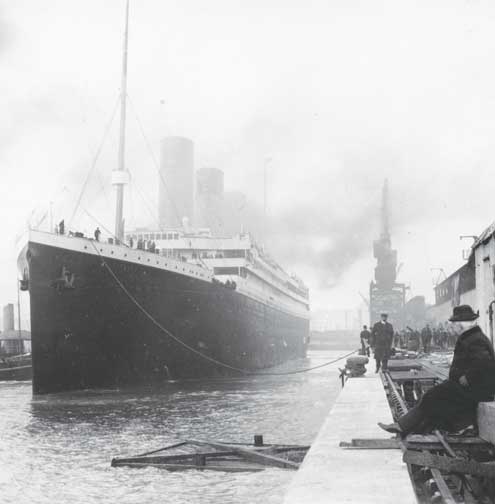


SERVICES
Tuesday April 10, 2012
Titanic - The Nova Scotia Connection
By Eamonn O'Loghlin When RMS Titanic sank the night of April 14, 1912, it was a human tragedy that was felt around the globe. Never before had the world experienced such a loss of life on the seas outside of wartime. However, there were two places where the sinking was particularly hard felt and where its 100th anniversary will be sadly remembered in events and exhibits throughout the year: Titanic's birthplace in Ireland and Halifax, Nova Scotia, where it was hoped the damaged ocean liner would dock safely and where many of her victims would be laid to rest. Titanic was a vessel five years in the making: two of them spent on design, with another three years of construction. The Belfast shipbuilding company Harland and Wolff was already renowned for its ability to produce the world's largest vessels, including the ships known as the Big Four (Celtic, Cedric, Baltic, and Adriatic) and the first of the White Star Line's Olympic class ocean liners, the Olympic. At the time, White Star was in fierce competition with the rival Cunard Line, a company founded and led by Halifax-born Samuel Cunard. Cunard had grown up in Nova Scotia to become intimately familiar with the shipping industry and was acutely aware of the value passengers placed on speed. His company's Mauretania and Lusitania had both set speed records for the fastest crossing of the Atlantic Ocean - bragging rights that gave the Cunard Line the edge for attracting customers. Rather than compete on speed, White Star decided to compete on the basis of luxury. The company wanted its second Olympic class ship, Titanic, to be even larger than her sister ship Olympic and offer passengers an opulence that had never before been seen in ocean liners. It was a daunting task but Harland and Wolff's Irish workforce was certainly up for the challenge. More than 3,000 men worked to build what would become the largest man-made moving object in the world, with engines each the size of a three-story house and a bow-to-stern length that would stretch four city blocks. It was tiresome and dangerous work, with five men losing their lives in Titanic's construction. In addition to the human effort to build her, it would cost $7.5 million (almost $400 million today) to build Titanic and get her ready to launch on May 31, 1911. The fate of Titanic is now one of the most well-known disasters in the world. The ship set sail from Southampton, England on April 10, 1912 - stopping to pick up additional passengers in Cherbourg, France and Queenstown (now Cobh), Ireland - bound for New York with over 2,200 people onboard. In the late hours of April 14, while most passengers slept, Titanic struck an iceberg in the north Atlantic. Less than three hours later, the great ship - often called 'unsinkable' by her designers and owner - sank beneath the waves, taking with it more than 1,500 men, women and children, including 110 Irish. Back on land, hope hadn't been immediately lost upon hearing Titanic's distress call. White Star officials in New York initially thought the damaged ship would still be able to limp into the closest major port, which was Halifax. Company executives, immigration officials and relatives of passengers boarded a train and made their way to the Nova Scotian capital expecting to meet the ship. However, their hopes were soon crushed when the first ship arrived at Titanic's location. The Cunard Liner Carpathia plucked more than 700 passengers from lifeboats and wired ashore to report that Titanic had sunk. A little over two days later, Halifax would again take an active role in the Titanic disaster. The port city was home to a number of ships that were specifically used to lay and repair underwater telegraph cables between Europe and North America. The men on these ships were experienced with the cold rough seas of the North Atlantic. Hours after the Titanic sank, the White Star Line commissioned these cable ships and their rugged crews to recover the bodies of victims. In the following days, the Halifax downtown and waterfront became a sad scene as the recovery ships arrived with Titanic's victims. Church bells would toll as horse-drawn hearses slowly made their way to a temporary morgue set up in the Mayflower Curling Rink. The Minia crew did manage to pick up numerous pieces of wood debris, including deck chairs, doors, chests of drawers, beautifully carved panels and other articles from the ship. In the following days, the Halifax downtown and waterfront became a sad scene as the recovery ships arrived with Titanic's victims. Church bells would toll as horse-drawn hearses slowly made their way to a temporary morgue set up in the Mayflower Curling Rink. Once there, the bodies were carefully arranged as to name and class: first class passengers in coffins, second and third class passengers in canvas bags, and crew members under blankets. Only 59 of the bodies in the morgue were returned by train to their families. The remaining 150 were given religious services and laid to rest in three local cemeteries: the non-denominational Fairview Lawn Cemetery, the Roman Catholic Mount Olivet Cemetery and the Jewish Baron de Hirsch Cemetery. Together, they represent the largest number of Titanic victims in one area. The White Star Line paid to have simple granite headstones placed on each grave. However, in some cases, friends, family and other groups purchased more elaborate headstones. The most famous of these was the headstone for the unknown child, paid for by the crew of the MacKay-Bennett. It wasn't until 95 years after his death that DNA testing identified the child as British toddler Sidney Goodwin. Sadly, Sidney's entire family - his parents and five siblings - also perished in the sinking and were never found. There's another grave in Halifax which also received significant attention, although not until the release of James Cameron's movie "Titanic" in 1997. The film renewed interest in the Titanic disaster and had fans and amateur historians alike poring over each scene to separate fact from fiction. So, when the grave of a "J. Dawson" was discovered in Halifax's Fairview Cemetery, many people jumped to the conclusion that it was the real-life inspiration for Leonardo DiCaprio's character Jack Dawson. In reality, J. Dawson was actually James Dawson, a 23-year-old native of Dublin, Ireland who signed onto the ship as a coal trimmer. Despite this reality, there is no doubt that James Dawson and his fellow crewmen deserve such fond remembrance for the sacrifices they made that fateful night in 1912. In recognition of the 100th anniversary of Titanic's sinking, there will be numerous commemorative events and special exhibits throughout Nova Scotia in 2012. Among them will be a salute to RMS Titanic at the Royal Nova Scotia International Tattoo, a special exhibit about the recovery efforts at the Maritime Museum of the Atlantic (which is also the permanent home of the largest collection of wooden Titanic artifacts in the world), and a special Titanic 100 Year Tour of local places of interest, including cemeteries, by Ambassatours Gray Line. For those interested in learning more about Nova Scotia's connection to the Titanic disaster, novascotia.com/titanic is a great place to start. The site will also allow you to plan your trip to Nova Scotia, see what is happening across the province in 2012 and even research your roots through its Routes to your Roots database. For anyone with an interest in the Titanic, Nova Scotia should feature at the top of your travel itinerary this year, with its unparalleled opportunity to experience the true enormity of the disaster. |
CURRENT ISSUE

RECENT ISSUES


SYNDICATE
[What is this?]
POWERED BY

HOSTED BY

Terms of Service | Privacy Policy
Website Design By C3I






